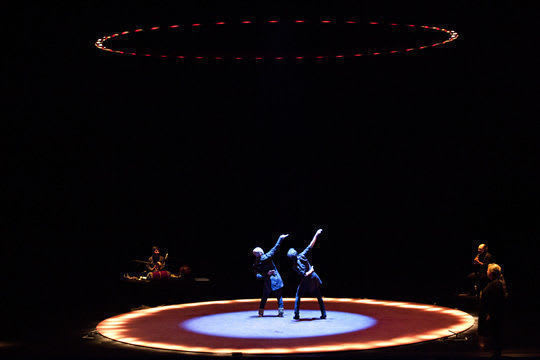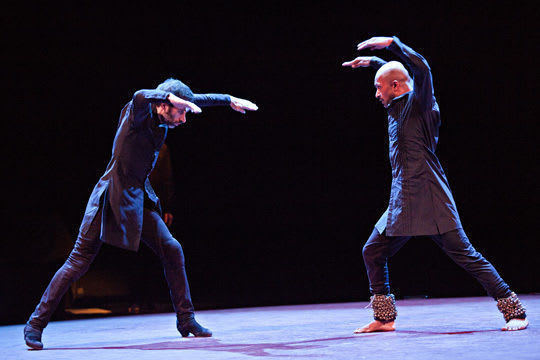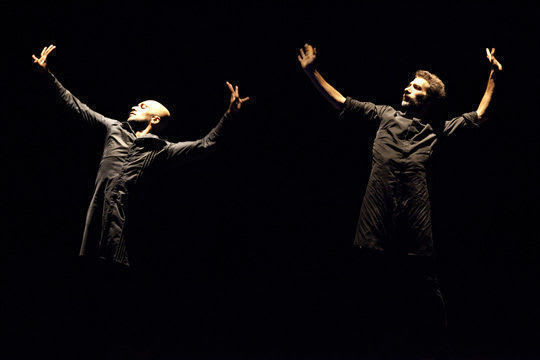Akram Khan & Israel Galván are both virtuoso dancers with their own personal choreographies that draw on their roots. Khan, British born of a Bangladeshi family, trained in the Kathak dance tradition and from it has developed his own idiosyncratic style while Spaniard Galván de les Reyes has a flamenco background.
The title Torobaka apparently has its origin in a Maori poem “Ka tanga ti kivi” which imitates various bird songs and which Dadaist poet Tristan Tzara transcribed as a cacophonous poem “Toro-Cava”, Spanish for “bull” and “cow”. The score's many natural sounding, non-verbal noises, setting and choreography all in some way reflect the Dadaist idea and the bull and cow which figure prominently in the cultures of both Spain and the Indian subcontinent.
Like Dada, Torobaka is a poem in sound, rhythm, movement and emotion that doesn’t set up any literary or literal meaning but impacts on the senses moment by moment. That doesn’t mean it is ideas-less for it explores competition, exchange, cooperation and even humour. Although the effect is of something brilliantly improvised, it is extremely carefully constructed.
It is played on a black stage, empty except for a couple of chairs and a low rostrum for B C Manjunath, who plays percussion, shruti box and woodwind. Singers and dancers are in nearly black costumes, the only colour the bright red of Manjunath’s tabla and Michael Hulls' lighting which makes a considerable contribution for it is always lovely to look at.
First Déjours presents a red-ringed arena than inevitably suggests the sand-strewn contest space of a bullring. A little more light reveals two barely distinguishable figures on the floor at the back: the dancers. Musicians enter: instrumentalist Manjunath, palmero (hand-clapper) and singer Bobote and singers David Azurza and Christine Leboutte.
When dancers and main singers stand together, the lights go down. As they gradually go up again, Khan and Galván are revealed together and begin a sequence that immediately establishes the pattern of what is to follow.
Arms, raised in what could be praise or astonishment, are gradually lowered and brought together, sounds are strangely organic with amplified clicks, choreography grows from natural gestures, a suggestion of martial arts poses, a quivering of Galván’s bare feet matches a zapateado rhythm, a tinkling bell sets Khan prancing. Galván howls, Khan reaches out to silence him, soon followed by the same in reverse and it becomes more of a contest as bare feet stamp out rhythms.
Movements will be shared, passed on, mirrored; Khan displays with a sharing, Galván is more proudly competitive. Choreography may become more mimetic, drawing on work gesture or animal movement: there are images drawn from the bullring or they could be stags locking antlers. There is stamping and more vocalisation, singing like plainsong.
In a new sequence, Galván returns alone, booted, making strange noises, doing his own thing. Kahn likewise, at one point banging rhythms on the earth with his forehead, or with flamenco boots on his hands instead of his feet in a partnership with palmero Bobote, a ground-based activity in contrast to his flickering limbs and rapid swirling. The singers too have their own section and their contribution and that of Manjunath is an integral part of the creation drawing on the same kind of raw energy and then mastering it.
Torobaka has an urgency that is closer to crew members taking centre spot in breakdance than balletic variations with a feeling more primeval than either that consistently holds the attention. By some kind of osmosis, each dancer is affected by the other one. Their dancing is loaded with feeling and energy and the virtuoso technique they display is amazing but this is not choreography designed to showcase skill but performance that keeps its audience alert with anticipation in what seems like a journey of discovery, an exploring and a challenge for both of them.
Previously reviewed when first seen at Sadlers’ Wells in November 2014 by Vera Liber.


